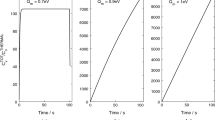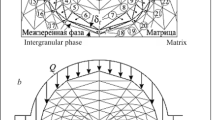Abstract
Experimental data are given on the effect of thermal, impurity, and nonstoichiometric vacancies on the diffusion creep in oxide ceramics in the range of high temperatures and low mechanical loads. It is demonstrated that impurity and nonstoichiometric vacancies have the main effect on creep in a material of technical purity grade. The experimental data are adequately described in the context of the quasichemical approach, in which the concentration of vacancies is determined by the mass effect law for the respective defect-forming reactions.
Similar content being viewed by others
REFERENCES
A. G. Evans and T. G. Langdon, Construction Ceramics [Russian translation], Metallurgiya, Moscow (1980).
V. S. Bakunov,“Specifics of high-temperature creep in ceramics,” Ogneup. Tekh. Keram., No. 12, 2–6 (1997).
V. S. Bakunov and A. V. Belyakov,“On the subject of analysis of ceramic structure,” Neorg. Mater., 32(2), 243–248 (1995).
J.-P. Poirier, Creep of Crystals, Cambridge University Press, Cambridge, Great Britain (1985).
Ya. E. Geguzin, Physic of Sintering [in Russian], Nauka, Moscow (1967).
I. M. Lifshits,“On the theory of diffusion-viscous flow in polycrystalline bodies,” Zh. Exp. Teor. Fiz., 44(4), 1349–1367 (1963).
A. Lid'yard, Ionic Conduction in Crystals [Russian translation], IL, Moscow (1962).
V. N. Chebotin, Physical Chemistry of Solids [in Russian], Khimiya, Moscow (1982).
P. V. Kovtunenko, Physical Chemistry of Solids. Crystals with Defects [in Russian], Vysshaya Shkola, Moscow (1993).
V. S. Bakunov, E. A. Voshchakin, K. I. Ryabtsev, et al.,“A device for studying thermomechanical properties of refractory materials in four-point bending,” Ogneupory, No. 2, 39–43 (1975).
V. S. Bakunov,“High-temperature creep in refractory ceramics. Densely sintered single-phase materials,” Ogneupory, No. 8, 5–12 (1994).
V. S. Bakunov,“High-temperature creep in refractory ceramics. Densely sintered multi-phase materials,” Ogneupory, No. 9, 2–8 (1994).
D. Dorn and D. Mote,“Physical principles of creep,” in: New Materials and Methods for Studying Metals and Alloys [Russian translation], Metallurgiya, Moscow (1966), pp. 248–328.
V. S. Bakunov, V. L. Balkevich, A. S. Vlasov, et al., High-Temperature Oxide Ceramics [in Russian], Metallurgiya, Moscow (1977).
A. M. Alper, R. N. Mac-Nally, P. H. Pibbe, R. C. Doman,“The System MgO-MgAl2O3,” J. Am. Ceram. Soc., 45(6), 263–268 (1962).
P. Kofstad, Nonstoichiometry, Diffusion, and Electrical Conductivity in Binary Metal Oxides, Wiley, New York (1975).
Author information
Authors and Affiliations
Rights and permissions
About this article
Cite this article
Bakunov, V.S., Belyakov, A.V. Diffusion Creep in Oxide Ceramics and Point Defects in Crystals. Glass and Ceramics 58, 341–346 (2001). https://doi.org/10.1023/A:1013951613692
Issue Date:
DOI: https://doi.org/10.1023/A:1013951613692




